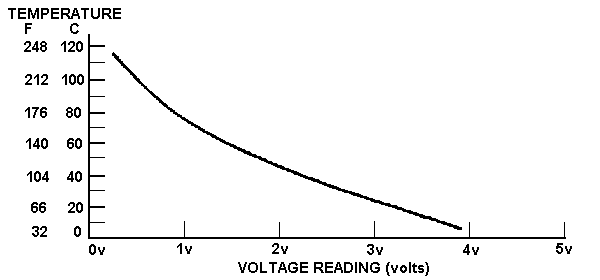Engine Coolant Temperature Sensor (ECT)

Before you start blaming the engine coolant temperature sensor and replacing it make sure the rest of the coolant system is in good condition. All of the following items will affect the ECT:
*Coolant level
*Radiator Fan
*Water Pump
*Water Pump and Fan Belts
*Thermostat
*Base Timing
*Engines general condition
*Harness and wire general condition
The Engine Coolant Temperature (ECT) sensor is a thermal transistor, which means it allows less electricity to pass through the sensor the warmer it gets. The ECT receives the "Signal Return" voltage from the EEC, then allows a certain amount to return back to the EEC. Because the ECT is in direct contact with the engine coolant flow it changes resistance in response to the temperature of that coolant.

The ECT is third in command in the hierarchy of EFI sensors, this means this sensor is very important when calculating fuel ratios and timing curves. This is because of simply chemistry; fuel and spark are constants in the equation. Air is the biggest variable in combustion; it changes density greatly over a range of temperature. So keeping track of the changing temperatures of the incoming air and the engine in which it is burnt becomes very important. But due to its simplicity of design, the ECT is rarely at fault when problems occur.
Before testing the ECT or any other EFI component perform a self-test, trouble codes received during test can be used as a diagnostic tool along with other indicators. To test an ECT sensor you will need a volt meter. You can test the ECT by back probing the harness while reading the voltage returning to the EEC. Or you can removing the connector completely and test the resistance between the 2 pins on the ECT. The engine temperature must be greater than 50°F (10°C) to pass the KOEO Self-Test and greater than 180°F (82°C) to pass the KOER Self-Test. To accomplish this, the engine should be at normal operating temperature.

|
Engine Coolant |
|||
|
Temperature |
Voltage |
Resistance |
|
|
F° |
C° |
Volts |
K ohms |
|
302 |
160 |
0.12 |
0.54 |
|
267 |
131 |
0.20 |
0.80 |
|
250 |
120 |
0.30 |
1.18 |
|
230 |
110 |
0.36 |
1.55 |
|
212 |
100 |
0.47 |
2.07 |
|
194 |
90 |
0.61 |
2.80 |
|
176 |
80 |
0.80 |
3.84 |
|
158 |
70 |
1.04 |
5.37 |
|
140 |
60 |
1.35 |
7.60 |
|
122 |
50 |
1.72 |
10.97 |
|
104 |
40 |
2.16 |
16.15 |
|
86 |
30 |
2.62 |
24.27 |
|
68 |
20 |
3.06 |
37.30 |
|
50 |
10 |
3.70 |
58.75 |
|
32 |
0 |
3.97 |
65.85 |
|
14 |
-10 |
4.42 |
78.19 |
|
-4 |
-20 |
4.87 |
90.54 |
|
-22 |
-30 |
4.89 |
102.88 |
|
-40 |
-40 |
4.91 |
115.23 |
Values were calculated for VREF=5.0 volts. These values may vary 15 percent due to sensor and VREF variations.
